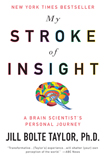Jill Bolte Taylor, Ph.D., a Harvard-trained brain scientist, woke up one morning with a sharp pain behind her left eye. She tried to continue with her morning routine, but one by one, her left brain lost its functions. Like dominoes, she lost the ability to walk normally, talk, read, write, or recall any of her life. In My Stroke of Insight (A Plume Book), Dr. Taylor describes her thoughts and progressively limiting reactions as she realized she was having a stroke.
Although her right hemispheric brain worked correctly, it was limited in what it could perceive from the non-functioning left brain. Dr. Taylor knew she needed help, but she no longer had the capability to figure out how to get it. Calling 9-1-1 did not occur to her. She did think of calling a doctor. She had gone to a particular doctor for the first time six months prior. Although she couldn’t remember the doctor’s name, she did remember the design, a right brain perception, on the doctor’s business card. Knowing it was imperative she receive help quickly, she clumsily pawed through her stack of business cards until she found the correct one. But then she found she could not discern numbers, she only saw unidentifiable squiggles. She painstakingly matched the squiggles on the card with those on the phone pad and managed to dial the number. Much to her dismay, when the doctor’s office answered, her voice came out garbled and she could not be understood. She then called a co-worker, after finally remembering the telephone number at work because it sounded like a rhyming jingle, again a right brain activity. When her colleague answered, he recognized the sound of her voice, even though he couldn’t understand the words. He immediately came to her assistance.
Diagnosis at the hospital revealed that Dr. Taylor had suffered a severe hemorrhage in the left hemisphere of her brain, caused by an undiagnosed AVM (arteriovenous malformation). AVM’s normally occur in people 25 – 45 years of age; Dr. Taylor was 37. She later described herself on the morning of the stroke so disabled she was like an infant in a woman’s body. She had surgery to remove a golf-ball sized blood clot and to remove excess blood from the left brain.
Dr. Taylor praises her mother who came to stay with her daughter in the initial months of recovery. Dr. Taylor had to learn everything from scratch: how to walk, talk, eat, read, write, dress herself. Learning to read again was the hardest and took years. In all, it was eight years before Dr. Taylor fully recovered from the stroke.
Recovery was a decision Dr. Taylor had to make “a million times a day.” The right brain was perfectly content to let matters float along in space, dwelling in a sort of “ecstatic bliss.” She knew the grueling work ahead of her if she chose the chaos of recovery. She had to constantly reaffirm that she was willing to go through that agony.
One of the important aspects of this book are the steps and influences necessary for others to observe in order to facilitate healing of a stroke or brain-injury patient. The author explains in detail what these steps are, such as needing people to treat her as though she would recover completely, or for people to offer only multiple-choice options and never ask yes/no questions.
As a brain scientist, Dr. Taylor’s explanation of how the brain perceives information gave me valuable insight. She goes into some detail as to the left brain (what you think) and right brain (what you feel) functions. She also discusses the conscious choices we make that affect ourselves and how we relate to others. The book offers inspiring testimony that inner peace is accessible to anyone. Much of the nature of these insights are not only useful to stroke or brain injury victims, but to those of us simply living our lives.
My Stoke of Insight offers tangible instructions useful for diagnosis and treatment of stroke. Dr. Taylor’s Warning Signs of Stroke are a valuable resource:
Warning Signs of Stroke
S – Speech, or any problems with language
T – Tingling, or any numbness in the body
R – Remember, or any problems with memory
O – Off Balance, problems with coordination
K – Killer headache
E – Eyes, or any problems with vision
STROKE is a medical emergency. Call 9-1-1
In addition, two appendices in the back provide valuable information. In Appendix A, “Recommendation for Recovery,” she lists ten assessment questions. In Appendix B she identifies “Forty Things I Needed Most to Recover.”
My Stroke of Insight provides valuable information about the human brain and particularly how it is affected by stroke. More than that, it gives us an opportunity to reevaluate our own lives and become aware of the choices we are capable of making.


